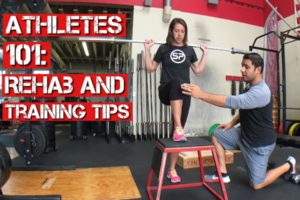
As the weeks roll on during the quarantine, motivation to stay active and pursue fitness goals may start to diminish. It’s perfectly natural to fall into a slump after doing the same bodyweight exercises or Instagram plank challenges for weeks at a time so I’ve decided to share some crucial ideas that may help inspire a new outlook on your fitness journey without the gym! It’s important to note that while these simple principles are helpful to readjust to our current situation, they are still applicable even after the gyms open and we go back to normal life.
1. Keep it Simple! Training doesn’t have to be complex to be productive and sometimes it’s even better to spend time working on the basics rather than trying to master 12 new exercises at a time and wondering if you’re doing them correctly. That’s why a performance specialist like myself spends time creating fun and simple exercise programs that are personalized and easy to understand and follow. So try searching for a simple plan you can stick to on the internet, create your own, or let me do all the thinking for you with performance training at Sports Performance!
2. Make your exercise fun! If you dread putting on your shoes to go workout, it might be time to rethink your training strategy. Long term fitness has to be consistent and enjoyable to be effective because if you aren’t having at least a little bit of fun during your workouts, you’ll likely burn yourself out trying to force yourself to keep up. Instead, start with something you truly enjoy and you may begin looking forward to those workouts instead of dreading them. For example, when I was in the military, I used to despise running long distances and I would avoid it even though I knew I needed to run as a job requirement. Over time, I found that I actually enjoyed running sprints a lot more than running for long periods of time so I opted for sets of 100-400m sprints that were challenging, fun, and gave me the endurance I needed.
3. Get creative and explore new styles of training. One of the coolest parts of my role training others is the opportunity I have to expose athletes to new methods of training! I’ve found that learning new exercises and even new sports can be extremely helpful in avoiding the mental burnout of doing the same exercises for weeks at a time. High Intensity interval training, functional fitness, sandbag training, and calisthenics are just a few styles that are becoming more popular during the COVID-19 gym closures but there are plenty of resources for training ideas on the internet and you can always come to me for help in finding the style that fits best for you.
4. Find ONE Weakness at a time and work on it I mentioned before that new exercises can be fun and challenging, but taking on too many new things at once can be discouraging, especially if you’re not able to perform some exercises. Try not to overwhelm yourself with new things and instead focus the majority of your training on exercises that are familiar and pick one weakness to work on a little bit at a time. For example, if you are doing a lot of calisthenics and want to be able to do more pull-ups. Spend about 80% of your time doing other exercises that you are good at and the other 20% devote to making measurable progress on the pull-up.
5. Set realistic goals and expectations Consistency is the key to lifelong progress in fitness (as well as many other areas of life) so when you’re beginning that journey be honest with yourself and determine how much time you can realistically spend exercising each week. If you have never been able to wake up at 5am to run 4 days a week, your determination to get fit may trick you into creating an unreasonable expectation of yourself and a slip up or missed workout could derail your motivation. Try this simple schedule instead: start by picking one day per week that you know you will have the time and commit to that day. By making small commitments to your fitness, you lay a foundation of confidence and consistency that will allow you to build up to more frequent workouts. After 3 weeks of consistent weekly compliance, add another day and repeat until your routine becomes a habit.
6. Just keep swimming! Setbacks happen and circumstances change so even if you haven’t been able to exercise for months or you’re upset at yourself for missing 1 workout, the important thing is that you keep moving forward and try not to let the past stand in the way of the future. Sometimes, a hectic few weeks or a couple missed sessions can cause someone to give up out of frustration so if you find yourself in this position, wipe the slate clean, revisit #5, and start fresh the next day. Don’t wait until the next Monday to make your changes as your motivation can shift dramatically in the span of a couple days and you may find yourself in the same spot.
7. Keep track of your progress! This is absolutely essential and it doesn’t matter how you do it, just that you have some way of looking back on all that you’ve accomplished. Not only is it extremely encouraging to see concrete evidence of the work that you’ve invested in yourself, it’s also helpful to see how much you’re doing now compared to how much you could do 2 months ago or 6 months ago. You can also look back on times where you were able to maintain consistency and compare them to your slumps to try and determine what changes you should make going forward. I recommend an app like google fit or myfitnesspal but it could be as simple as making a note on your phone or writing it down in a notebook; whatever you need to do to keep a record of your achievements.
As always, we hope this helps! If you have any questions or if you would like to read about certain topics, feel free to send us an email at TeamSP@SportsPerformancePT.com.
-Coach Alex

STAY CONNECTED
Instagram: CLICK HERE
Facebook: CLICK HERE
YouTube: CLICK HERE
Podcast: CLICK HERE
TUNE IN TO OUR PODCAST












